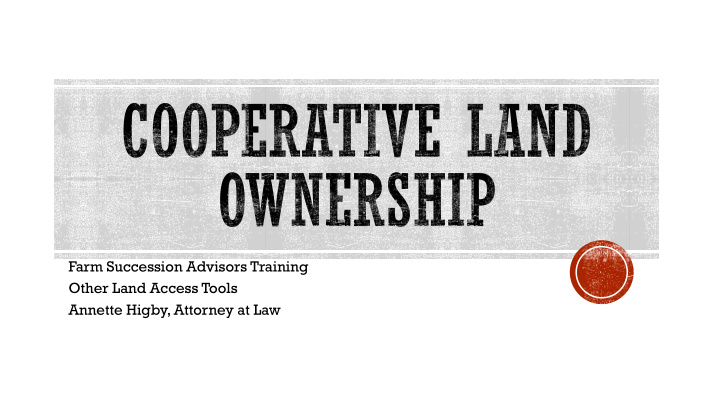



Farm Succession Advisors Training Other Land Access Tools Annette Higby, Attorney at Law
§ Potential for providing affordable land access for multiple producers on one farm property. § Unique legal structure with respect to voting rights, distribution of profits, initial capital contributions, and the purposes of the business. § See Comparative Chart
§ In a non-cooperative business voting rights usually (but not always) determined by capital share. § In a cooperative legal structure, every member has one vote regardless of capital share.
§ In a non-cooperative business, profits are usually (but not always) distributed on the basis of capital share. § In a cooperative legal structure, profits are distributed in proportion to the member’s use of the cooperative. § A “patronage dividend” encourages members to do business with the co-op rather than some other business. § In a land co-op, the patronage paid is rent or other assessments to cover the co-ops costs.
§ In a non-cooperative business, initial capital contributions can vary a great deal. § In a cooperative legal structure, initial capital contributions are most often equal. § Some state statutes limit the percentage of capital that can be owned by any one member.
§ In a non-cooperative business, the purpose of the business is to make money for its shareholders or members. § In a cooperative legal structure, the purpose of the business is to provide goods and services to its members at cost. § Profits are returned to members on the basis of their patronage.
International Cooperative Alliance, Cooperative Principles: Voluntary and Open Membership 1. Democratic Member Control 2. Member Economic Participation – equal and democratic 3. Autonomy and Independence – retain member control 4. Education, Training and Information – leadership development among members 5. Cooperation among cooperatives 6. Concern for Community 7.
State Cooperative Formation Statutes in New England § Specific formation requirements for producer marketing co-ops, consumer co-ops, worker co-ops and credit unions. § In some states you may also form a cooperative under the general corporation formation statute if the entity meets certain requirements related to cooperative principles. § One member, one vote § Minimum number of members § A reserve requirement § No member may own more than 10% of the capital § Not always a good fit.
Poudre Valley Community Farms § A Colorado based multi-Stakeholder cooperative still in the formative stage. § Members are to be farmers, consumers and restaurants. § Farmers rent land at market rates. § Patronage dividends paid on the basis of food purchased from co- op producers. § Multi-Stakeholder co-ops can present conflicts of interest
Lost Meadow Land Cooperative West Corinth, Vermont § Multi-Stakeholder land cooperative – residential land cooperative looking for new farmer member. § Ground Leases for home sites for a 20 year, renewable term. § Lessees pay real estate taxes, carrying charges and assessments. § Improvements are owned by the Lessees and may not be sold without Co-op Council consent. § Lease is inheritable.
Lost Meadow Land Cooperative West Corinth, Vermont § Members purchase one or more common shares at price determined by Council. § Net profits allocated on the basis of member patronage. § Redemption only available on terms as determined by the Council and only when replacement capital is available. § One member, one vote.
Feasibility Case Study § 4 separate farming operations explored feasibility of cooperative land ownership of a farm capable of supporting two diversified vegetable operations, one dairy and one beef operation. § Membership was to be limited to farmers, and rental payments would form the basis of patronage. § Purchase price was $574,000. Cooperative Fund of New England required 20% in cash equity or $27,612 per member.
Feasibility Case Study § Initial capital outlay was too steep for several of the prospective members. § Annual debt service financed through lease payments was also a challenge for some. § Other members preferred to invest limited capital into their own farming operations rather than a land cooperative. § Many landowners in the area were offering land access for free. § Operations were all at varying stages of development and viability. § For the newer operations the prospect of committing capital, time, and energy into a new entity was not appealing.
Well Spring Land Co-op Marshfield, VT § Legal structure is very similar to Lost Meadow. § Two house sites were split off from the co-op to enable members to obtain a mortgage. § In addition to a ground lease for the home site, members enter into an agricultural lease for farm land.
§ Cooperative land ownership can make land access more affordable. § Start with a feasibility study! § If multi-stakeholder, identify and address conflicts of interest. § Educate clients on unique legal structure and cooperative governance. § Taxation is unique and specialized tax advice is essential.
§ State cooperative formation statutes can be arcane and not a good fit. § Farm operations should be in a similar developmental stage and in similar economic status. § Difficulty of obtaining a mortgage on homes and agricultural improvements. § Consider redemption and dissolution provisions carefully.
Recommend
More recommend